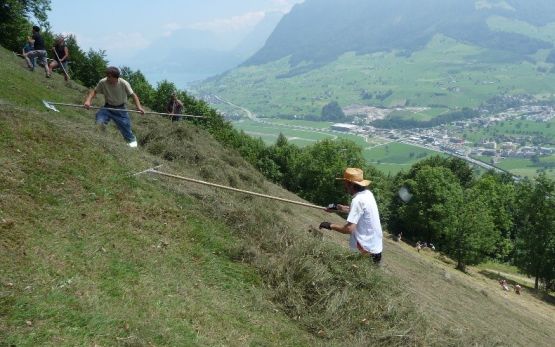Regarding this issue, the effect of hay blowers on flora and various mowing devices on fauna have been the focus of investigations in recent years.

Leaf blowers
The use of hay blowers has led to discussions regarding the implementation of the measure in practice, which has made clarifications regarding possible implications for biodiversity necessary. Dry meadows and other species-rich mountain grasslands are endangered habitats, often with a high biodiversity whose preservation is vital. Here, the focus is on the management practices used, as the traditional hay harvest using rakes is being replaced by faster and more economical methods. In recent years, the use of hay blowers has become increasingly popular. But does this trend affect the vegetation? To answer this question, Agroscope launched a project on behalf of Pro Natura in 2010. The aim was to investigate the possible effects of hay blowers on the plant diversity of species-rich mountain meadows such as dry meadows.
No significant differences
A dry meadow in Stans (Canton of Nidwalden) was divided into 10 comparable plots on which hay was either harvested with a hand rake or a hay blower. In 2010 to 2015 and in 2023 Agroscope specialists surveyed the vegetation on the neighbouring mown and raked plots. After 13 years, there was no evidence of any significant differences in terms of species diversity, species composition, target and indicator species of the Agriculture -Related Environmental Objectives (AEOs) or moss cover between the two management practices. Based on these studies, the continued use of hay blowers to harvest semi-arid grasslands and other species-rich mountain meadows need not be discouraged. What is important here is that the plots be grazed or mown, and that the grass clippings be removed to prevent shrub encroachment.
Survival in the Eco-Meadow
For the preservation and promotion of animals, different provisions or financial incentives are discussed in practice for the use of fauna-saving harvesting equipment and processes. However, it is unclear just which measures make sense.
The promotion and preservation of extensively managed meadows are among the most important measures for achieving our national environmental objectives in the sphere of agriculture. We are investigating how such meadows should be managed, where they should be established, and what measures should be used to promote animal and plant species that have become rare.
Does it make sense to prescribe or reward fauna-sparing mowing techniques for extensively managed meadows when we don’t know weather these benefits are all undone by the subsequent harvest steps such as warping, baling and removal? To discover whether this is the case, we compare the effect of different harvest processes on the fauna in extensively managed meadows. Using investigations in the field – especially those involving grasshoppers and butterfly caterpillars – and based on dummies, the effects of the different harvest steps, harvest machines and refuges are appraised. Policy and practical recommendations are issued for target-compliant management of eco-meadows.
Conducted in partnership with Prof. Jaboury Ghazoul (Institute for Terrestrial Ecosystems, ETH Zurich), the project was supported by the conservation and/or agricultural agencies of the cantons of Aargau, Bern, Basel-Landschaft, Fribourg, Glarus, Graubünden, Nidwalden, Lucerne, St. Gallen, Schaffhausen, Vaud, Zug and Zurich.





